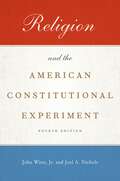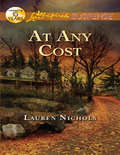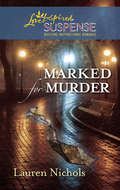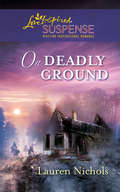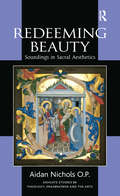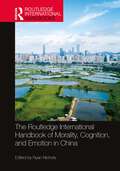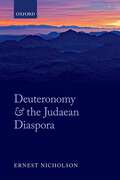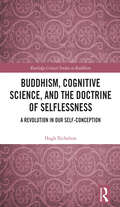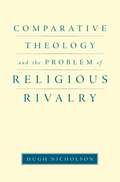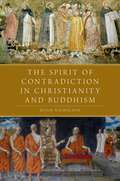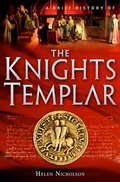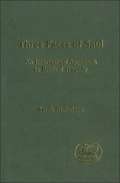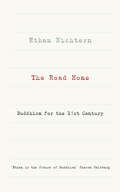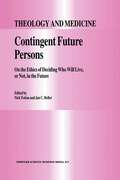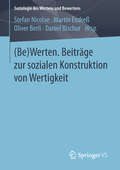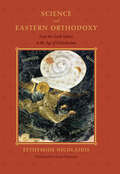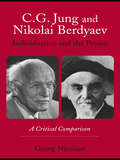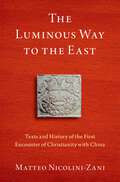- Table View
- List View
Religion and the American Constitutional Experiment
by Joel A. Nichols John Witte, Jr.This accessible introduction tells the American story of religious liberty from its colonial beginnings to the latest Supreme Court cases. The authors provide extensive analysis of the formation of the First Amendment religion clauses and the plausible original intent or understanding of the founders. They describe the enduring principles of American religious freedom--liberty of conscience, free exercise of religion, religious equality, religious pluralism, separation of church and state, and no establishment of religion--as those principles were developed by the founders and applied by the Supreme Court. Successive chapters analyze the two hundred plus Supreme Court cases on religious freedom--on the free exercise of religion, the roles of government and religion in education, the place of religion in public life, and the interaction of religious organizations and the state. A final chapter shows how favorably American religious freedom compares with international human rights norms and European Court of Human Rights case law. Lucid, comprehensive, multidisciplinary, and balanced, this volume is an ideal classroom text and armchair paperback. Detailed appendices offer drafts of each of the religion clauses debated in 1788 and 1789, a table of all state constitutional laws on religious freedom, and a summary of every Supreme Court case on religious liberty from 1815 to 2015. Throughout the volume, the authors address frankly and fully the hot button issues of our day: religious freedom versus sexual liberty, freedom of conscience and its limitations, religious group rights and the worries about abuse, faith-based legal systems and their place in liberal democracies, and the fresh rise of anti-Semitism, Islamophobia, and anti-Christianity in America and abroad. For this new edition, the authors have updated each chapter in light of new scholarship and new Supreme Court case law (through the 2015 term) and have added an appendix mapping some of the cutting edge issues of religious liberty and church-state relations.
At Any Cost (Mills And Boon Love Inspired Suspense Ser.)
by Lauren NicholsNO ESCAPE Hiding from the past, jumping at shadows…Welcome to Jenna Harper’s life ever since her ex decided murder was the way to punish her for moving on. Yet Jenna survived—and continuous survival means eluding her attacker: no unnecessary risks, no credit cards and definitely no men.
Marked for Murder (Mills And Boon Love Inspired Ser.)
by Lauren NicholsThe Gold Star serial killer is back…
On Deadly Ground (Mills And Boon Love Inspired Suspense Ser.)
by Lauren NicholsDANGER IN THE DARKNESS The prowler on the construction site of her new camp didn’t frighten Rachel Patterson…at fi rst. Fear comes when her home is torched—and worsens when a body is unearthed on the campgrounds. Someone’s trying to cover up a murder, and if Rachel can identify the intruder, she might be the only witness.
Redeeming Beauty: Soundings in Sacral Aesthetics (Routledge Studies in Theology, Imagination and the Arts)
by Aidan Nichols O.P.Redeeming Beauty explores the richness of orthodox Christian tradition, both Western and Eastern, in matters of 'sacral aesthetics' - a term used to denote the foundations, production and experience of religiously relevant beauty. Aidan Nichols investigates five principal themes: the foundation of beauty in the natural order through divine creative action; explicitly 'evangelical' beauty as a quality of biblical revelation and notably at its climax in Christ; the legitimacy of making and venerating artworks; qualities of the self in relation to objective presentation of the religiously beautiful; and the difficulties of practising a sacral aesthetic, whether as producer or consumer, in an epoch when the visual arts themselves have left behind not only Church but for the greater part the public as well. The thought of theologians such as Augustine, Aquinas, Balthasar, Ratzinger, Bulgakov, Maritain and others are explored.
Redeeming Beauty: Soundings in Sacral Aesthetics (Routledge Studies in Theology, Imagination and the Arts)
by Aidan Nichols O.P.Redeeming Beauty explores the richness of orthodox Christian tradition, both Western and Eastern, in matters of 'sacral aesthetics' - a term used to denote the foundations, production and experience of religiously relevant beauty. Aidan Nichols investigates five principal themes: the foundation of beauty in the natural order through divine creative action; explicitly 'evangelical' beauty as a quality of biblical revelation and notably at its climax in Christ; the legitimacy of making and venerating artworks; qualities of the self in relation to objective presentation of the religiously beautiful; and the difficulties of practising a sacral aesthetic, whether as producer or consumer, in an epoch when the visual arts themselves have left behind not only Church but for the greater part the public as well. The thought of theologians such as Augustine, Aquinas, Balthasar, Ratzinger, Bulgakov, Maritain and others are explored.
The Routledge International Handbook of Morality, Cognition, and Emotion in China (Routledge International Handbooks)
by Ryan NicholsThis ground-breaking handbook provides multi-disciplinary insight into Chinese morality, cognition and emotion by collecting in one place a comprehensive collection of essays focused on Chinese morality by world-leading experts from more than a dozen different academic fields of study. Through fifteen substantive chapters, readers are offered a holistic look into the ways morality could be interpreted in China, and a broad range of theoretical perspectives, including ecological, anthropological and cultural neuroscience. Offering a syncretic, multi-disciplinary overview that moves beyond the usual western-oriented perspective of China as a monolithic culture, research questions addressed in this book focus on morality as represented at the level of the individual, rather than at the group or institutional levels. Research questions explored herein include: What are the major contours of distinctively Chinese morality? What was the role of the ancient ecology, climate, and pathogen load in producing Chinese moral attitudes and emotions? Are ingredients of the good life in China different than ingredients of the good life elsewhere? How are children in China morally educated? How do findings from cultural neuroscience help us understand differences in the treatment of family members, or the treatment of strangers, in China and elsewhere? How do the protests in Hong Kong participate in, or stand apart from, the ongoing ethics of protest in historical China? The clear structure and accessible writing offer a rigorous assessment of the ways in which morality can be interpreted, shedding light on differences between China and Western cultures. The book also provides a timely window into Chinese forms of morality, and the pivotal role these play in social organization, family relationships, systems of government, emotion and cognition. Representing fields of study ranging from philosophy, linguistics, archaeology, history, and religion, to social psychology, neuroscience, clinical psychology, developmental psychology, and behavioral ecology, this is an essential text for students, academics, and others with wide interest in Chinese culture.
The Routledge International Handbook of Morality, Cognition, and Emotion in China (Routledge International Handbooks)
by Ryan NicholsThis ground-breaking handbook provides multi-disciplinary insight into Chinese morality, cognition and emotion by collecting in one place a comprehensive collection of essays focused on Chinese morality by world-leading experts from more than a dozen different academic fields of study. Through fifteen substantive chapters, readers are offered a holistic look into the ways morality could be interpreted in China, and a broad range of theoretical perspectives, including ecological, anthropological and cultural neuroscience. Offering a syncretic, multi-disciplinary overview that moves beyond the usual western-oriented perspective of China as a monolithic culture, research questions addressed in this book focus on morality as represented at the level of the individual, rather than at the group or institutional levels. Research questions explored herein include: What are the major contours of distinctively Chinese morality? What was the role of the ancient ecology, climate, and pathogen load in producing Chinese moral attitudes and emotions? Are ingredients of the good life in China different than ingredients of the good life elsewhere? How are children in China morally educated? How do findings from cultural neuroscience help us understand differences in the treatment of family members, or the treatment of strangers, in China and elsewhere? How do the protests in Hong Kong participate in, or stand apart from, the ongoing ethics of protest in historical China? The clear structure and accessible writing offer a rigorous assessment of the ways in which morality can be interpreted, shedding light on differences between China and Western cultures. The book also provides a timely window into Chinese forms of morality, and the pivotal role these play in social organization, family relationships, systems of government, emotion and cognition. Representing fields of study ranging from philosophy, linguistics, archaeology, history, and religion, to social psychology, neuroscience, clinical psychology, developmental psychology, and behavioral ecology, this is an essential text for students, academics, and others with wide interest in Chinese culture.
Deuteronomy And The Judaean Diaspora
by Ernest NicholsonIn Deuteronomy and the Judaean Diaspora Ernest Nicholson challenges the widely accepted view that Deuteronomy was the 'book of the law' described in 2 Kings 22-3 as the basis of king Josiah's cultic reformation in 621 BCE. He argues that the notice in this narrative that Josiah abolished the rural, local altars throughout Judah and supposedly relocated their priests to Jerusalem is based upon a misreading. Rather, he contends, Deuteronomy derived from thinkers and writers who lived among the Judaean exiles in Babylonia in the sixth century, and in significant ways represents a break with pre-exilic Israelite religion occasioned by the urgent need to confront the challenges to national identity and cultural survival of the Judaean Diaspora community. Leading features of the book such as its zealous monolatry, its self-presentation as 'scripture', its concept of the relationship with God as covenanted choice, its pervasive fear of religious encroachment, its character as 'oppositional' literature—these and other themes of the book suggest such a provenance. Issues arising include, for example, information from Babylonian sources, some of it new, about the Judaean exiles, how Israel is characterised in the book, kingship, evidence of the emergence of a body of prophetic 'scripture'. Two final chapters examine the 'Deuteronomistic History' (Joshua-2 Kings) and show that (contrary to some interpretations) it is not 'historiography' such as is represented by, for example, Herodotus' Histories, and that theodicy rather than an interest in the past as a field of critical study best describes its genre.
Buddhism, Cognitive Science, and the Doctrine of Selflessness: A Revolution in Our Self-Conception (Routledge Critical Studies in Buddhism)
by Hugh NicholsonThis book examines the relationship between Buddhist philosophy and scientific psychology by focusing on the doctrine of No-self. The hypothesis is that No-self can function as an instrument of counter-induction, that is, an alternative conceptual scheme that exposes by contrast the intuitive or "folk" theoretical presuppositions sedimented in our perception of ourselves and others. When incorporated into regimens of meditative and ritual practice, the No-self doctrine works to challenge and disrupt our naïve folk psychology. The author argues that there is a fruitful parallel between the No-self doctrine and anti-Cartesian trends in the cognitive sciences. The No-self doctrine was the product of philosophical speculation undertaken in the context of hegemonic struggles with both Buddhist and non-Buddhist rivals, and the classic No-self doctrine, accordingly, is a somewhat schematic and largely accidental anticipation of the current scientific understanding of the mind and consciousness. Nevertheless, inasmuch as it challenges and unsettles the seemingly self-evident certitudes of folk psychology, it prepares the ground for the revolution in our self-conception promised by the emerging cognitive scientific concept of mind. A novel contribution to the study of Buddhist Philosophy, the book will also be of interest to scholars of Buddhist Studies and Asian Religions.
Buddhism, Cognitive Science, and the Doctrine of Selflessness: A Revolution in Our Self-Conception (Routledge Critical Studies in Buddhism)
by Hugh NicholsonThis book examines the relationship between Buddhist philosophy and scientific psychology by focusing on the doctrine of No-self. The hypothesis is that No-self can function as an instrument of counter-induction, that is, an alternative conceptual scheme that exposes by contrast the intuitive or "folk" theoretical presuppositions sedimented in our perception of ourselves and others. When incorporated into regimens of meditative and ritual practice, the No-self doctrine works to challenge and disrupt our naïve folk psychology. The author argues that there is a fruitful parallel between the No-self doctrine and anti-Cartesian trends in the cognitive sciences. The No-self doctrine was the product of philosophical speculation undertaken in the context of hegemonic struggles with both Buddhist and non-Buddhist rivals, and the classic No-self doctrine, accordingly, is a somewhat schematic and largely accidental anticipation of the current scientific understanding of the mind and consciousness. Nevertheless, inasmuch as it challenges and unsettles the seemingly self-evident certitudes of folk psychology, it prepares the ground for the revolution in our self-conception promised by the emerging cognitive scientific concept of mind. A novel contribution to the study of Buddhist Philosophy, the book will also be of interest to scholars of Buddhist Studies and Asian Religions.
Comparative Theology and the Problem of Religious Rivalry (AAR Reflection and Theory in the Study of Religion)
by Hugh NicholsonIn theological discourse, argues Hugh Nicholson, the political goes "all the way down." One never reaches a bedrock level of politically neutral religious facts, because all theological discourse - even the most sublime, edifying, and "spiritual"--is shot through with polemical elements. Liberal theologies, from the Christian fulfillment theology of the nineteenth century to the pluralist theology of the twentieth, have assumed that religious writings attain spiritual truth and sublimity despite any polemical elements they might contain. Through his analysis and comparison of the Christian mystical theologian Meister Eckhart and his Hindu counterpart ÍaSkara, Nicholson arrives at a very different conclusion. Polemical elements may in fact constitute the creative source of the expressive power of religious discourses. Wayne Proudfoot has argued that mystical discourses embody a set of rules that repel any determinate understanding of the ineffable object or experience they purport to describe. In Comparative Theology and the Problem of Religious Rivalry, Nicholson suggests that this principle of negation is connected, perhaps through a process of abstraction and sublimation, with the need to distinguish oneself from one's intra- and/or inter-religious adversaries. Nicholson proposes a new model of comparative theology that recognizes and confronts one of the most urgent cultural and political issues of our time: namely, the "return of the political" in the form of anti-secular and fundamentalist movements around the world. This model acknowledges the ineradicable nature of an oppositional dimension of religious discourse, while honoring and even advancing the liberal project of curtailing intolerance and prejudice in the sphere of religion.
The Spirit of Contradiction in Christianity and Buddhism
by Hugh NicholsonThe cognitive science of religion has shown that abstract religious concepts within many established religious traditions often fail to correspond to the beliefs of the vast majority of those religions' adherents. And yet, while the cognitive approach to religion has explained why these "theologically correct" doctrines have difficulty taking root in popular religious thought, it is largely silent on the question of how they developed in the first place. Hugh Nicholson aims to fill this gap by arguing that such doctrines can be understood as developing out of social identity processes. He focuses on the historical development of the Christian doctrine of Consubstantiality, the claim that the Son is of the same substance as the Father, and the Buddhist doctrine of No-self, the claim that the personality is reducible to its impersonal physical and psychological constituents. Both doctrines are maximally counterintuitive, in the sense that they violate the default expectations that human beings spontaneously make about the basic categories of things in the world. Nicholson argues that that these doctrines were each the products of intra- and inter-religious rivalry, in which one faction tried to get the upper hand over its ingroup rivals by maximizing the contrast with the dominant outgroup. Thus the "pro-Nicene" theologians of the fourth century developed the concept of Consubstantiality in the context of an effort to maximize, against their "Arian" rivals, the contrast with Christianity's archetypal "other," Judaism. Similarly, the No-self doctrine stemmed from an effort to maximize, against the so-called Personalist schools of Buddhism, the contrast with Brahmanical Hinduism with its doctrine of an unchanging and eternal self. In this way, Nicholson shows how religious traditions, to the extent that their development is driven by social identity processes, can back themselves into doctrinal positions that they must then retrospectively justify.
The Spirit of Contradiction in Christianity and Buddhism
by Hugh NicholsonThe cognitive science of religion has shown that abstract religious concepts within many established religious traditions often fail to correspond to the beliefs of the vast majority of those religions' adherents. And yet, while the cognitive approach to religion has explained why these "theologically correct" doctrines have difficulty taking root in popular religious thought, it is largely silent on the question of how they developed in the first place. Hugh Nicholson aims to fill this gap by arguing that such doctrines can be understood as developing out of social identity processes. He focuses on the historical development of the Christian doctrine of Consubstantiality, the claim that the Son is of the same substance as the Father, and the Buddhist doctrine of No-self, the claim that the personality is reducible to its impersonal physical and psychological constituents. Both doctrines are maximally counterintuitive, in the sense that they violate the default expectations that human beings spontaneously make about the basic categories of things in the world. Nicholson argues that that these doctrines were each the products of intra- and inter-religious rivalry, in which one faction tried to get the upper hand over its ingroup rivals by maximizing the contrast with the dominant outgroup. Thus the "pro-Nicene" theologians of the fourth century developed the concept of Consubstantiality in the context of an effort to maximize, against their "Arian" rivals, the contrast with Christianity's archetypal "other," Judaism. Similarly, the No-self doctrine stemmed from an effort to maximize, against the so-called Personalist schools of Buddhism, the contrast with Brahmanical Hinduism with its doctrine of an unchanging and eternal self. In this way, Nicholson shows how religious traditions, to the extent that their development is driven by social identity processes, can back themselves into doctrinal positions that they must then retrospectively justify.
A Brief History of the Knights Templar: A New History (Brief Histories)
by Professor in Med Helen NicholsonMuch has been written about the Knights Templar in recent years. A leading specialist in the history of this legendary medieval order now writes a full account of the Knights of the Order of the Temple of Solomon, to give them their full title, bringing the latest findings to a general audience. Putting many of the myths finally to rest, Nicholson recounts a new history of these storm troopers of the papacy, founded during the crusades but who got so rich and influential that they challenged the power of kings.
Three Faces of Saul: An Intertextual Approach to Biblical Tragedy (The Library of Hebrew Bible/Old Testament Studies)
by Sarah NicholsonA fascinating intertextual study of the classic biblical tragedy of Saul, the first king of Israel, as first narrated in biblical narrative and later reworked in Lamartine's drama Saul: Tragédie and Thomas Hardy's novel The Mayor of Casterbridge. Plot and characterization are each explored in detail in this study, and in each of the narrations the hero's tragic fate emerges both as the result of a character flaw and also as a consequence of the ambivalent role of the deity, showing a double theme underlying not only the biblical vision but also its two very different retellings nearer to our own times.
The Road Home: Buddhism for the 21st century
by Ethan Nichtern'An invitation to a sane life' Jack KornfieldDo you feel at home? Are you comfortable in your own skin? Do you have a sense of belonging?In this book, senior Buddhist teacher Ethan Nichtern addresses these questions and guides us on the path we all take to find out who we really are and where we really belong. Feeling truly at home, he believes, comes not from our physical location but the ability to belong in the present moment, without worrying about yesterday's regrets or tomorrow's to-do list. Nichtern provides the tools needed to reach this awakening.Once we feel relaxed and comfortable in our own skin, our lives improve. We become less anxious, uncertain and stressed about the future; we become more able to listen, to be compassionate and engage in meaningful relationships and activities. We can all achieve this, if only we can feel at home with ourselves and others. This book is not about navel-gazing or escapism, instead it is a map to use in everyday life - one that ultimately leads you home.
Contingent Future Persons: On the Ethics of Deciding Who Will Live, or Not, in the Future (Theology and Medicine #9)
by Nick Fotion and Jan C. HellerHow ought we evaluate the individual and collective actions on which the existence, numbers and identities of future people depend? In the briefest of terms, this question poses what is addressed here as the problem of contingent future persons, and as such it poses relatively novel challenges for philosophical and theological ethicists. For though it may be counter-intuitive, it seems that those contingent future persons who are actually brought into existence by such actions cannot benefit from or be harmed by these actions in any conventional sense of the terms. This intriguing problem was defined almost three decades ago by Jan Narveson [2], and to date its implications have been explored most exhaustively by Derek Parfit [3] and David Heyd [1]. Nevertheless, as yet there is simply no consensus on how we ought to evaluate such actions or, indeed, on whether we can. Still, the pursuit of a solution to the problem has been interestingly employed by moral philosophers to press the limits of ethics and to urge a reconsideration of the nature and source of value at its most fundamental level. It is thus proving to be a very fruitful investigation, with far-reaching theoretical and practical implications.
**Missing** (Soziologie des Wertens und Bewertens)
by Stefan Nicolae Martin Endreß Oliver Berli Daniel BischurFragen der Wertigkeit prägen gegenwärtig alle Lebensbereiche. Ziel dieses Auftaktbandes der neuen Publikationsreihe „Sociology of Valuation and Evaluation (SVE) / Soziologie des Wertens und Bewertens“ ist die Anregung eines sozialwissenschaftlichen Dialogs zu Phänomenen des Wertens und Bewertens über disziplinäre Analysen hinweg, in dem theoretische und methodische Zugriffe sowie methodologische Implikationen einer vergleichenden Soziologie des Wertens und Bewertens thematisiert werden. Dieser Anspruch wird in der programmatischen Einführung sowie den konzeptionellen Studien entfaltet und durch Beiträge zu den Themenfeldern Bildung und Wissenschaft empirisch untersucht.Der Inhalt● Konzeptionelle Studien: Sozialkalkulation; Vom Komparativ zum Superlativ; Vielfältige Formen des Engagiert-Seins als Grundlage von Gemeinschaft und Persönlichkeit; Sichtbarkeit und Emotionalität als Elemente von Bewertungsprozessen; Positionierungsmacht; Zur Kontextualisierung von Bewertungsprozessen ● Empirische Studien: Empfehlungen und Marktwert; Organisierte Humanevaluation; Folgen universitärer Leistungsbewertungen für das berufliche Handeln von Hochschulprofessoren; Urteilen unter Beobachtung; Bewertungspraktiken in klinischen RäumenDie HerausgeberDr. Stefan Nicolae ist wissenschaftlicher Mitarbeiter der Professur für Allgemeine Soziologie der Universität Trier.Dr. Martin Endreß ist Professor für Allgemeine Soziologie der Universität Trier.Dr. Oliver Berli ist wissenschaftlicher Mitarbeiter der Professur für Erziehungs- und Kultursoziologie der Universität zu Köln.Dr. Daniel Bischur ist wissenschaftlicher Mitarbeiter der Abteilung Soziologie und Ethnologie der Universität Trier.
Science and Eastern Orthodoxy: From the Greek Fathers to the Age of Globalization (Medicine, Science, and Religion in Historical Context)
by Efthymios NicolaidisPeople have pondered conflicts between science and religion since at least the time of Christ. The millennia-long debate is well documented in the literature in the history and philosophy of science and religion in Western civilization. Science and Eastern Orthodoxy is a departure from that vast body of work, providing the first general overview of the relationship between science and Christian Orthodoxy, the official church of the Oriental Roman Empire. This pioneering study traces a rich history over an impressive span of time, from Saint Basil’s Hexameron of the fourth century to the globalization of scientific debates in the twentieth century. Efthymios Nicolaidis argues that conflicts between science and Greek Orthodoxy—when they existed—were not science versus Christianity but rather ecclesiastical debates that traversed the whole of society. Nicolaidis explains that during the Byzantine period, the Greek fathers of the church and their Byzantine followers wrestled passionately with how to reconcile their religious beliefs with the pagan science of their ancient ancestors. What, they repeatedly asked, should be the church’s official attitude toward secular knowledge? From the rise of the Ottoman Empire in the fifteenth century to its dismantling in the nineteenth century, the patriarchate of Constantinople attempted to control the scientific education of its Christian subjects, an effort complicated by the introduction of European science in the seventeenth and eighteenth centuries. Science and Eastern Orthodoxy provides a wealth of new information concerning Orthodoxy and secular knowledge—and the reactions of the Orthodox Church to modern sciences.
Science and Eastern Orthodoxy: From the Greek Fathers to the Age of Globalization (Medicine, Science, and Religion in Historical Context)
by Efthymios NicolaidisPeople have pondered conflicts between science and religion since at least the time of Christ. The millennia-long debate is well documented in the literature in the history and philosophy of science and religion in Western civilization. Science and Eastern Orthodoxy is a departure from that vast body of work, providing the first general overview of the relationship between science and Christian Orthodoxy, the official church of the Oriental Roman Empire. This pioneering study traces a rich history over an impressive span of time, from Saint Basil’s Hexameron of the fourth century to the globalization of scientific debates in the twentieth century. Efthymios Nicolaidis argues that conflicts between science and Greek Orthodoxy—when they existed—were not science versus Christianity but rather ecclesiastical debates that traversed the whole of society. Nicolaidis explains that during the Byzantine period, the Greek fathers of the church and their Byzantine followers wrestled passionately with how to reconcile their religious beliefs with the pagan science of their ancient ancestors. What, they repeatedly asked, should be the church’s official attitude toward secular knowledge? From the rise of the Ottoman Empire in the fifteenth century to its dismantling in the nineteenth century, the patriarchate of Constantinople attempted to control the scientific education of its Christian subjects, an effort complicated by the introduction of European science in the seventeenth and eighteenth centuries. Science and Eastern Orthodoxy provides a wealth of new information concerning Orthodoxy and secular knowledge—and the reactions of the Orthodox Church to modern sciences.
C.G. Jung and Nikolai Berdyaev: A Critical Comparison
by Georg NicolausThis book explores C. G. Jung's psychology through the perspective of the existential philosopher Nikolai Berdyaev, drawing striking parallels between Jung's theory of individuation and Berdyaev's understanding of the person. Placing Jung and Berdyaev firmly within the context of secular humanism, Nicolaus draws on their personal experiences of individuation to show how both writers seek to enable a renewal of our self-understanding as persons in a post-religious society. Topics of discussion include: the foundations of Berdyaev's personalism Jung's psychological interpretation of the Christian God-image individuation and the ethics of creativity. C. G. Jung and Nikolai Berdyaev: Individuation and the Person offers a fresh perspective on the ethical implications of Jung’s theory and serves also as an introduction to Berdyaev’s thought. As such this book will appeal to analytical psychologists, scholars engaged with Jungian thought and all those interested in the interface between spirituality and depth psychology.
C.G. Jung and Nikolai Berdyaev: A Critical Comparison
by Georg NicolausThis book explores C. G. Jung's psychology through the perspective of the existential philosopher Nikolai Berdyaev, drawing striking parallels between Jung's theory of individuation and Berdyaev's understanding of the person. Placing Jung and Berdyaev firmly within the context of secular humanism, Nicolaus draws on their personal experiences of individuation to show how both writers seek to enable a renewal of our self-understanding as persons in a post-religious society. Topics of discussion include: the foundations of Berdyaev's personalism Jung's psychological interpretation of the Christian God-image individuation and the ethics of creativity. C. G. Jung and Nikolai Berdyaev: Individuation and the Person offers a fresh perspective on the ethical implications of Jung’s theory and serves also as an introduction to Berdyaev’s thought. As such this book will appeal to analytical psychologists, scholars engaged with Jungian thought and all those interested in the interface between spirituality and depth psychology.
The Luminous Way to the East: Texts and History of the First Encounter of Christianity with China (AAR Religion in Translation)
by Matteo Nicolini-ZaniThe Luminous Way to the East offers a comprehensive survey of the historical, literary, epigraphic, and archaeological sources of the first stage of the Christian mission to China. It explores the complex and multifaceted process of the interaction with the different cultural and religious milieux that the Church of the East experienced in its diffusion throughout Central Asia and into China during the first millennium. Matteo Nicolini-Zani provides an overview of the Christian presence in China during the Tang dynasty (618-907) by reconstructing the composition and organization of Christian communities, the geographical location of Christian monasteries, and the related historical events attested by the sources. Through a new and richly annotated English translation of the Chinese Christian texts produced in Tang China, the volume provides a documented look at what was the earliest, and perhaps the most extraordinary, encounter of Christianity with Chinese culture and religions (Confucianism, Daoism, and Buddhism). It shows how East Syriac Christianity in its eastward expansion along the Silk Road from Persia to China was open to the adoption of other languages and imagery and was able to enculturate the Christian teaching into new cultural and religious forms without losing its identity.
The Luminous Way to the East: Texts and History of the First Encounter of Christianity with China (AAR Religion in Translation)
by Matteo Nicolini-ZaniThe Luminous Way to the East offers a comprehensive survey of the historical, literary, epigraphic, and archaeological sources of the first stage of the Christian mission to China. It explores the complex and multifaceted process of the interaction with the different cultural and religious milieux that the Church of the East experienced in its diffusion throughout Central Asia and into China during the first millennium. Matteo Nicolini-Zani provides an overview of the Christian presence in China during the Tang dynasty (618-907) by reconstructing the composition and organization of Christian communities, the geographical location of Christian monasteries, and the related historical events attested by the sources. Through a new and richly annotated English translation of the Chinese Christian texts produced in Tang China, the volume provides a documented look at what was the earliest, and perhaps the most extraordinary, encounter of Christianity with Chinese culture and religions (Confucianism, Daoism, and Buddhism). It shows how East Syriac Christianity in its eastward expansion along the Silk Road from Persia to China was open to the adoption of other languages and imagery and was able to enculturate the Christian teaching into new cultural and religious forms without losing its identity.
